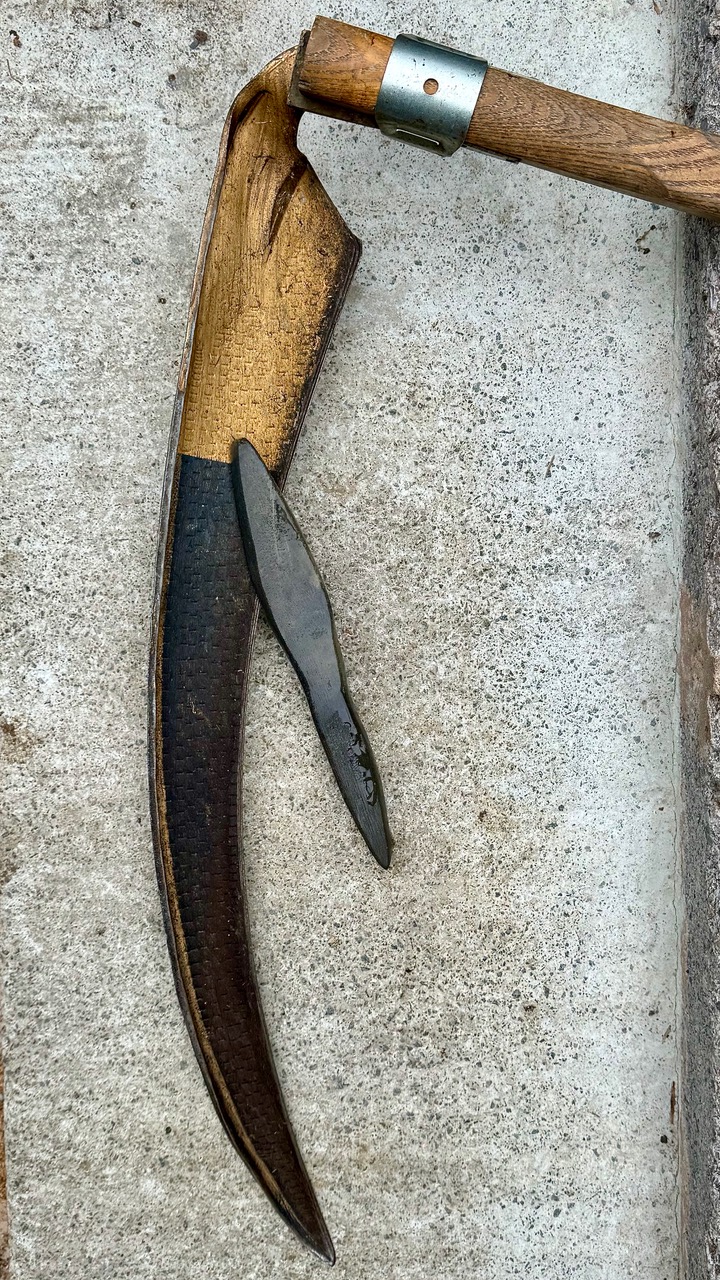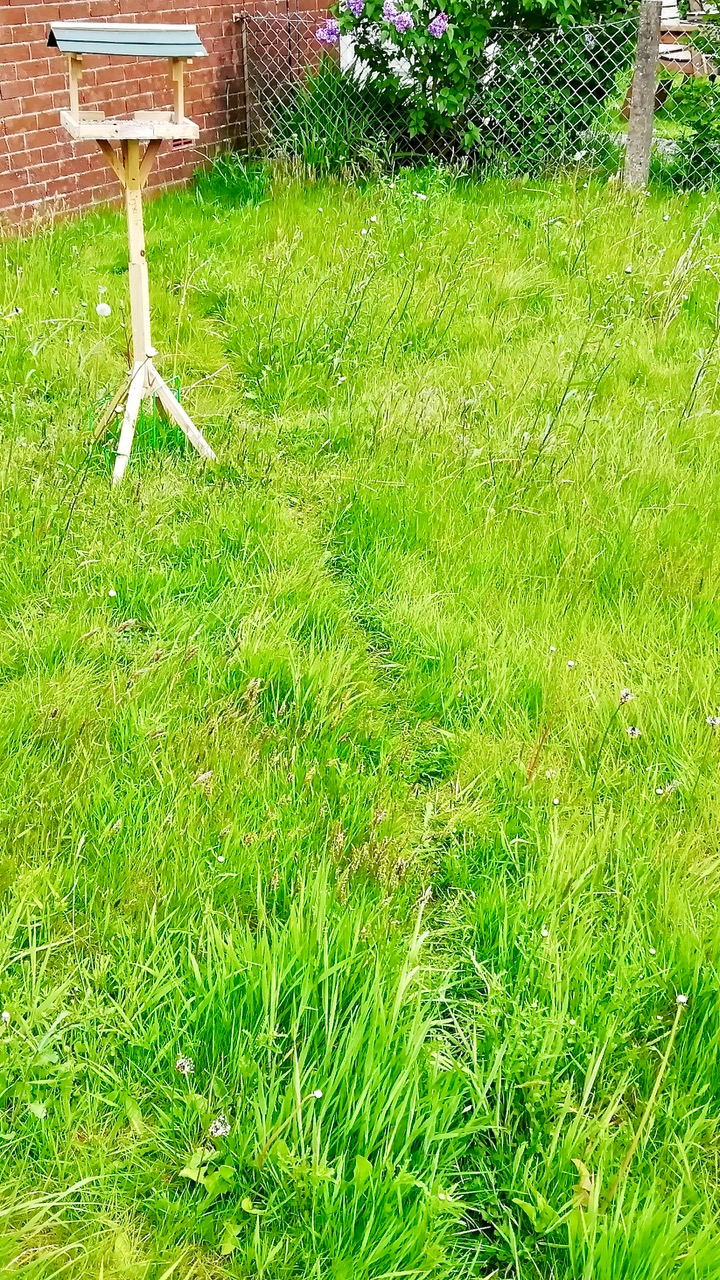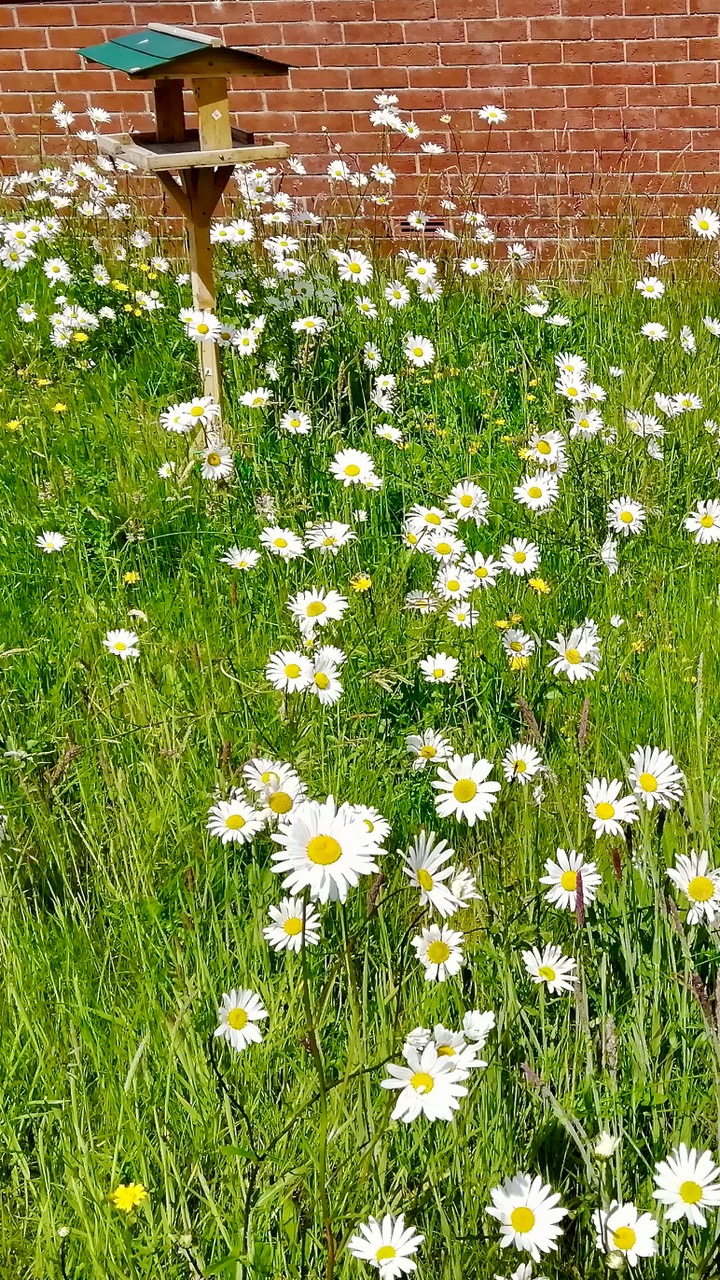Quiet, non-polluting, kind to wildlife, people-powered, earth-friendly: scythes win over strimmers on every count – but sometimes you need to see to believe.
It’s the sound that pulls them in – the harsh, honing rip of stone against steel isn’t an everyday sound here. As soon as I start sharpening, heads start to turn. ‘Is that a knife?’ asks a young boy whose bike has screeched to a halt. I tease him, asking when was the last time he saw a knife blade attached to the end of a wooden handle this long. ‘So if it’s not a knife…?’ I explain that together, the long, shiny curving blade and the pale wooden handle – the snath – are called a scythe.
‘Did you cut the grass with it?’ asks a young girl, holding a woman’s hand. She points at the neat rows of dry, sun-warmed grass lying across the small rectangular lawn-that-was. I grab a fistful of the mix of fading grasses and flower seedheads, explaining that I’ve made a little bit of hay, which horses like to eat, and ask her to give it a sniff.
‘It’s sweet, and it’s got pretty flowers in it,’ is the coy response. I tell her this is a very special part of the garden called a mini meadow, like a bit of big grassy field right next to the house. ‘I could hide in the long grass!’ she says, delighted.

I tell her she would be hiding in there with other wild things, like spiders, beetles, ants, frogs and toads, mice, perhaps even a slow worm (which I explain is a lizard with no legs), and that during the summer she could watch bumblebees and butterflies flying over her head. ‘So they all live in the mini… um, meadow? Is that their home?’ I nod, pointing to a spider running over the bunch of hay. Spiders really love living here, I say.
A few passing teens have joined us. ‘Why aren’t you using one of those noisy strimmer things, mate?’ On cue, a ‘strimmer thing’ starts its incessant whine several streets away. I tap my ear and mow another strip, then ask them what they can hear. ‘Dunno, not much really, kind of a swishing noise, I guess.’ I explain how no one can hear me working even one street away, and that scythes don’t disturb anyone’s peace.
The boys all nod. They get it. I resist mounting a full-on high horse about urban noise pollution, despite another strimmer joining the earache chorus (it is a beautiful day, after all). Is that a lawnmower firing up? Deep breath.
Some adults have joined us, as curious but less forthcoming than the children. ‘Why not just mow it and get the job done?’ chips in a middle-aged man. ‘Because creatures live in there!’ says the little girl, who’s still sniffing a handful of hay. ‘The mower would hurt them because it has big teeth in it, doesn’t it?’ I’ve not been asked that one before, but I agree that lawnmowers do have teeth made of metal, and they can chop creatures up. The man seems unconvinced; you don’t win them all. As I mow another strip, I ask if anyone can guess something else you don’t get when you use a scythe.
I hear brains whirring, and wink a clue by taking a deep sniff. ‘Stinky smell!’ yelps the girl. She’s good, this one. To make the point, a faint whiff of badly combusted petrol wafts by. ‘I hate it. Mr Williams is always filling our garden with stinky smell when I’m playing out. Can we have a mini with creatures, mummy, please?’ Her mother throws me a knowing smile and tells her daughter they can talk to daddy about it. A seed has been sown. It’s music to this mower’s ears.

Another high horse moment is resisted – this time about how scythes are powered by human not fossil fuel. I settle for explaining how they don’t make our air pollution any worse. Sighting a plume of grey-white smoke from a distant bonfire, I do another big, calming inhale. Always on the fine days…
‘Hard work then, is it?’ asks a white-haired man in a string vest. I decide to joust a little and ask him if it looks it. ‘You’re sweating a bit, but it looks like a decent workout to me. I could do with it!’ He chuckles, patting his beer belly. I decide to let rip and wax lyrical (scythical?) about how mowing with a scythe is an all-out gentle workout that’s good for the muscles and the mind (mindfulness might be a word too far). When I effuse about its therapeutic properties, eyebrows twitch. He won’t know until he tries it.
‘Heavy, is it?’ I hook a finger under the snath and offer it, to see for himself. ‘Wow, that’s no weight at all. I used to have an old metal one in the shed that weighed a ton.’
More waxing scythical, as I explain that this is an Austrian scythe with an ash handle, and that scythes are still used in Europe to maintain flower-rich meadows and steep ground along roads. English scythes are the cumbersome heavy ones. He asks me to chop some more, to which I reply I’ll gladly mow another strip.
I pause to put stone against steel again, explaining how the blade must stay razor sharp to cut cleanly and easily through the stems. I hear the gasps as I flick the sharpening stone from side to side along the blade – but there’s no blood spilt. I’ve been at this gig a while.
Pulling a handful of bits of yellow, orange and green plastic from my pocket, I ask if anyone can guess what else scythes are good at not doing. ‘I’ve seen this stuff around after they’ve cut the grass by our bungalows,’ says an elderly woman. I offer a clue by encouraging them to listen; there are three strimmers on the whine now. Puzzled looks – then the older man starts nodding. ‘The line – that’s bits of cutting line from the strimmer heads.’

These bits of plastic, I explain, get lost in the soil and create more pollution that will be around for hundreds of years. I remind my audience that scythes don’t pollute, whether it’s noise, air or plastic. The nods tell me they get it.
‘Can anyone do it?’ The boy, who’s put his phone away, is captivated. Anyone can learn to use a scythe, I tell him. I explain that it’s a skill that gets better the more you practice, and that the best way to learn is to go on a course. I gently deflate their youthful enthusiasm by telling them that scythes don’t, sadly, come in children’s sizes. The little girl looks crestfallen, but recovers quickly as she points excitedly at the last strip left to mow. ‘Look, there!’
I gently brush glinting steel over the movement in the long grass. ‘No, don’t hurt it!’ cries the little girl, biting a nail and leaning over the fence. As I’m reassuring her that I’m just making sure that whatever it is is safe, before I mow the last bit of grass, she points down, gobsmacked. A slow worm glides silently through the mown grass between my legs, disappearing under a raked-up pile of hay. ‘Mummy, look, the slow lizard’s found a new home!’
The show’s over, and my audience peels away; it’s teatime. I’m checking whether the slow worm has scarpered or is still under the heap when a young man, who’s been watching quietly, asks if I’ve got a minute. ‘This is just what we need around here!’ Bursting with enthusiasm, he explains how a lot of local people want the common areas and the playing field to be more eco-friendly, and that rather than being constantly chopped down by mowers and strimmers, perhaps they could instead be mown (he got that right) with a scythe. Or several scythes. Or even a whole gang of folk with scythes.
Does it sound feasible? Can I advise on how to go about it? Will I help to train people up? Yes, yes and yes. There’s funding for green projects. He’s keen. So am I.
We make a date to talk scythes.
Text and images © John Walker
Join John on X @earthFgardener


